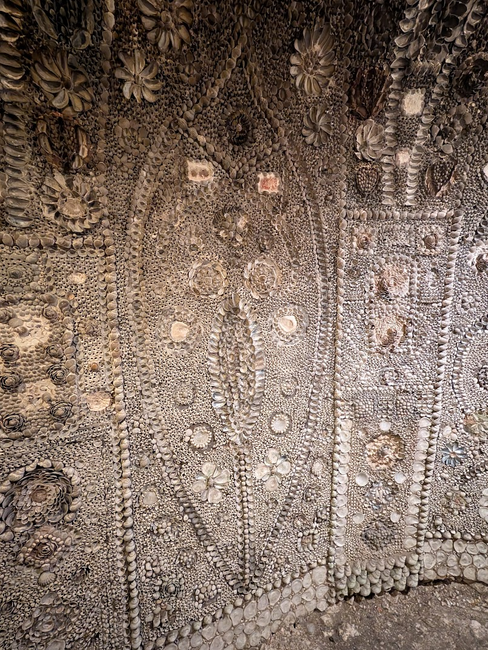Shells, a Hole in the Ground, and Turner
- chirp54
- Nov 2
- 4 min read
On a previous visit to England we had visited Whitstable, which we enjoyed in spite of, and because of, its somewhat old fashioned seaside atmosphere. This time we decided to visit Margate. I suppose I expected another sleepy seaside town but that's not what I got. It reminded me more of Blackpool, Lancashire. Now, if you haven't been to Blackpool, I can best describe it as a town disguised as amusement park. Lots of neon, lots of cotton candy (candy floss) lots of bad food and cheap hotels. To my mind, ever so tacky. Pare that back a bit and you have Margate. It looks like a place that has seen better days and is struggling to find relevance. The high street is full of shuttered storefronts and those stores that are open are mostly charity shops, vape shops and fast food. It's all a bit sad. But there are things that are worth seeing. One of those is the Shell Grotto.

I'd love to share the history of the grotto, but it is shrouded in mystery. There's a sign mounted on the wall near the entrance that reads, "Why was it built? When? Who By? We don't know."
What they do know is that it was discovered around 1835 when the owner of Belle Vue cottage was having renovations carried out and, digging through a wall, exposed a hole. Excavating further, they made the incredible discovery of the tunnels of the grotto. Within a few years it had become a local attraction and has remained one ever since.
It's not known if the grotto was a temple, a secret meeting place or just a folly. While Greece was home to the earliest grottos, Renaissance Italy saw them surge in popularity. The fashion spread across Europe, reaching Britain in the 1600s. In the 18th century, Britons returning from their grand tour of Europe often commissioned shell rooms and shell grottos, which is what this could be. There are, however, other theories that say it could have been a meeting place of the Knights Templar or the Freemasons. Since the 2007 discovery of a domed cave under the Palatine Hill in Rome with shells, mosaics and marble in similar patterns to those in the rectangular chamber in Margate, some credence has been given to the theory that the Shell Grotto could have been created by the Phoenicians in the second half of the first millennium BCE, when they were founding many colonies from their base in Carthage. Perhaps the very mystery of its origins forms part of its allure.
Climbing down a steep set of stairs you enter an other-worldly series of corridors covered in over 4 million shells in various patterns. It sounds quite simple, but it's pretty astounding.




Tree of life design:

Quite an extraordinary place. From there it was a short walk to the Margate Caves. The tourist adverts say it features cave paintings, the thought of which I found quite exciting, picturing something like the Lascaux caves in France. Yeah, no. It turns out that the Margate caves were originally dug as a chalk mine, and the paintings in the caves are mostly new, with a couple of faint outlines of paintings from the mid 19th century.



The caves are geared toward children and there are many special children's events held here. I h never been in a chalk mine before, so I settled on that experience as the win.
From the caves Bruce went in search of old pubs and I walked to the seafront to the Turner Contemporary gallery.

JMW Turner first went to Margate as a child, staying with relatives while his mother battled mental illness in London; he also attended school there. In his later years, he would stay with a Captain Booth and his wife in a guesthouse which was located close to where the museum now sits. When Captain Booth died, Turner adopted the last name Booth and he and Mrs. Booth moved to Chelsea. Turner was an English Romantic painter, printmaker, and watercolorist who was known for his expressive coloring, imaginative landscapes and turbulent, often violent marine paintings. In his later years, he experimented with more modern, abstract painting, to the dismay of many of his critics. Perhaps it's fitting, then, that this museum is filled with contemporary, modern art.
The featured exhibition was of the works of Anna Boghiguian. Her work is massive and her new installation, The Salt Traders, is a poetic reflection on salt's global history. Though it looks like the floor is covered in sand, it's actually covered in various types of salt.

Though it doesn't really come across well in these photos, it was fascinating.
Another of her installations was The Square, The Line, and the Ruler, Ambiguous Philosophers, Ambiguous Politicians. This was in the form of a giant chessboard with the pieces suspended above it. The pieces were double sided, with a philosopher on one side and a politician on the other.


Should you be interested in the descriptions of those represented, zoom in to these:


There is only one painting by Turner in the museum and I heard several disgruntled tourists lamenting the fact that they'd wanted to see Turners, not "this rubbish." Oh, well. The Turner in question, Breaking Waves on a Seashore, was never publicly displayed in his lifetime.

After lunch at a trendy restaurant called Dory's, I walked along the seaside to the train. You have to give the railway advertisers high marks for imagination.




















Comments